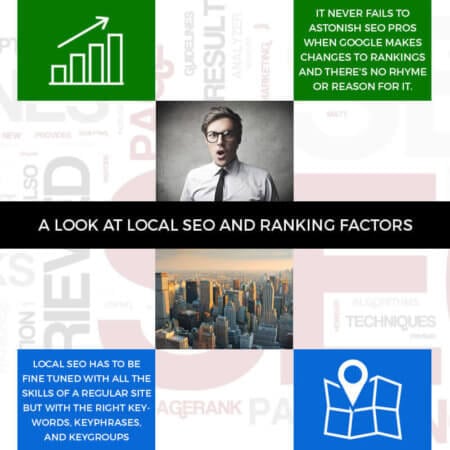 It never fails to astonish SEO pros when Google makes changes to rankings and there’s no rhyme or reason for it. Knowing ‘why’ Google chooses to raise a ranking is the goal of all SEO experts and that goes especially for the competitive Local SEO market.
It never fails to astonish SEO pros when Google makes changes to rankings and there’s no rhyme or reason for it. Knowing ‘why’ Google chooses to raise a ranking is the goal of all SEO experts and that goes especially for the competitive Local SEO market.
One might think keywords, links, shares, likes, are all ranking factors and in some degree all are, however Google is scaring the bejeezus out of SEO pros when they rank a site higher and there’s no way to figure out why. All the experts can do is pour over the stats and metrics and look for a pattern to exploit.
This may not be doable with Google as their AI experiments are so far ahead of the pack it even scares their own people, many of whom have retired as the software AI seems to be writing itself. With their suite of search engine software working 24/7 and being improved upon regularly, Google no longer informs the public of updates which leaves marketers and SEO pros hovering over their stats like vultures waiting for the kill.
Local SEO is a specialized form of SEO so that local companies or companies located in other areas but have outlets or personnel and customers in a specific region, that targets that locale. It has to be fine tuned with all the skills of a regular site but with the right keywords, keyphrases, and keygroups placed strategically so that Google will find them and list them properly. That comes to the issue of branded and non-branded results. It is proving tricky as news emerges of changes in this regard that experts can’t fathom.
This mystery as to why some sites recently shot up and some shot down is probably not going to be answered anytime soon but you can bet there will be eyes peeled on every statistic and metric there is to try to decipher what Google is doing and will do next.
As pros work on this, it’s going to be best understood in the long term. Why? Because in 3 to 6 months there will be enough statistical data to make some form of analysis and conclusion. Then new strategies have to be developed based on the theories or if some news leaks out that Google doesn’t want the marketers and SEO hounds to know.
The best bet for SEO experts and the ranking factors is to run a tight ship. Don’t toss out tried and true procedures. They’re probably the only thing holding your campaigns together. Google is looking for sites that serve the public and are penalizing sites they feel are too spammy or get bad reviews from customers. Google may be gathering metric data that no one else can or has and is incorporating that into their software in ways it’s too difficult for present day SEO marketers to understand, yet.
That being the case, the bottom line is to keep your sites clean and useful. Professionally constructed with helpful links and great, updated content. Don’t just advertise a sea food restaurant, but declare that it’s a great sea food restaurant located at the specific address, in the specific county and state with zip codes added. Make sure all authority links have your local date included if possible and put as much of your location data in your titles and tags and descriptions but do so naturally, fluidly, and in the right places.
Pose and answer questions in regard to the product and services of said business and include the location in each. Such as, “Where’s the best seafood restaurant in Bug Tussle, Oklahoma?” then reply in the answer, “The best seafood restaurant in Bug Tussle, Oklahoma 00000 (zip code) is Joe’s Seafood Shop.”. This gives a double dose of location data and provides a service. Ask for comments too from surfers and satisfied customers. It all adds up in the branding and organic traffic which are the overall goals.
Local SEO and ranking factors are a continual challenge and you’ll have to keep your finger on the pulse as best you can with this industry. It takes a scientist and artist and engineer to fathom it all, but where there’s persistence, there’s victory.
